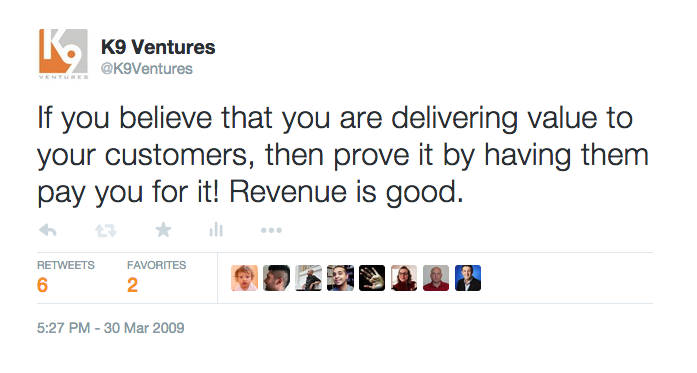I’ll start by admitting up front that the purpose of this post is to hopefully incite a discussion, to start a fire, and to get you, and your startup to think really hard about what your business model should be. The title for this post ‘The Case Against FREE’ is a throwback to Chris Anderson‘s cover story in Wired Magazine titled Free: Why $0.00 Is the Future of Business, but, this post isn’t really intended to be a blow-by-blow rebuttal of Chris Anderson’s position. It just makes for a juicy title for me to express my opinion on startup business models (or often the lack thereof).
At the core of my argument is a short tweet that I’ve sent out at least twice on Twitter:
To elaborate: Too many startups feel like the right price point for them to start out is “free.” What they fail to realize is that once you start offering a valuable service for free it is very difficult to later charge for that same service. And if that service happens to be the core value of what you have to offer, well, then you’ve just given it away. Yes, you can claim to use a “freemium” model in order to charge for added features or services over and above your core service, but, if you give away the most valuable part of your service, the uptake on the number of people who convert to the for-pay premium services is not going to be very high.
I’ve seen way too many companies fall into this trap. In a lot of instances, companies fell into this trap because of competition. And yes, competition is a good thing for consumers; it encourages companies to build better product, deliver better value and, in some cases, give away everything for “free.” That last part is the one that I’m going to take issue with. Competing on price isn’t always a good thing. If you want to compete, compete by innovating, compete by out-smarting, compete on quality, and on really solving the customer’s problem in a better way. If you compete by making the price of your most valuable offering zero, then all you have succeeded in doing is create a “divide by zero” problem for yourself, and, if you’re even a little bit of a geek you know that that’s a NaN.
Contrary to Chris Anderson’s view on Free, I strongly believe that the best revenue models are where money changes hands directly. You deliver real value to me, and I happily pay you some reasonable amount of $$s for that value. That has always been the fundamental basis for business and it will remain the fundamental basis for business for the foreseeable future. That core principal of where money changes hands for value delivered is an invariant that must exist in every real and sustainable business. Whether you do it by using a direct exchange or a three way exchange or any other way doesn’t matter much. If you’re not making money, then you’re not really building a sustainable business (no wonder so many startups are jokingly referred to as defacto “non-profits!”).
In my opinion, there are very few of the three way business models that work. Google is obviously one where it does work, and it works brilliantly. But not every startup is going to be able to pull that off, and especially not for every type of product offering. Advertising has always been a three party model and lots (okay, maybe “some” is a better word here) of companies make lots money using an advertising model (ala Google); but I am partial to a direct revenue model. That’s my opinion and I’m sticking to it.
Let me give an example: Plaxo. I often rail on Plaxo because I believe that they started out with a brilliant idea. Managing contacts is a huge problem and honestly no one has had a better shot of really solving that problem than Plaxo. They did a few things right: The ability for updates to be propagated across the network was great in concept. Having all my contacts backed up to the cloud, and be able to sync across multiple machines and devices was great. But, they also got a few things wrong: They were using email a little bit too liberally to where it created the perception of being a generator of spam. Most of all, the biggest mistake Plaxo made (in my opinion) was that they started to give away their core value for free. That core value that Plaxo delivered was backing up and synchronizing the data in Outlook. There were multiple occasions when Outlook crashed or the computer crashed and the only way to recover that valuable contact data was to resync with Plaxo, and boy am I thankful to them for that! But, they gave it away for free and then never really found a reasonable upsell to build a real business model for the company.
I won’t even start about what I call the “critical mass plays” — businesses that hope to monetize based on traffic and advertising. That model isn’t flawed, it’s just overly optimistic. Very few companies ever get to having enough critical mass to make it work.
The last thing you want to do is compete in a commodity market place. The mentality of ‘Free’ and the mentality of acquire users first, and figure out how to make money later (see the next post coming up soon for more on iterating the business model) is creating an environment that puts our companies in a commodity market. Are we really selling lean hogs or coffee? I thought we were in an industry where innovation matters. If innovation matters, then prove it by building a better product — one that your customers will be happy to pay you real $$s for.

![Reblog this post [with Zemanta]](http://img.zemanta.com/reblog_e.png?x-id=a7d00a6f-0b5b-4527-86a4-54871e0aaaab)